
Background information
Experience report from the Boston Marathon
by Patrick Bardelli
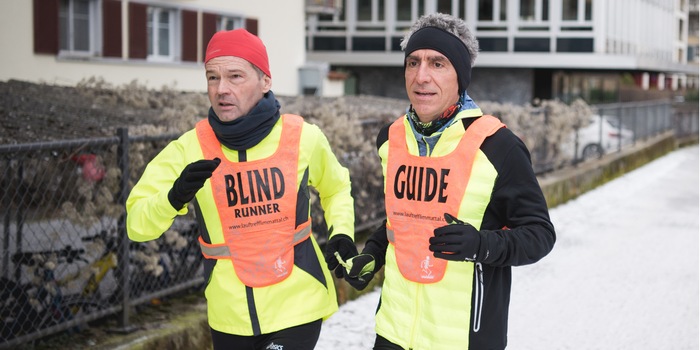
His penetrating gaze is the first thing I notice about him. As I sit opposite him, I somehow already sense what he means when he says later in the conversation: "I just have to do it." Meeting Mike Bär, running guide.
It's cold outside, but loud inside sphères. This is where I meet Mike Bär and Hans-Peter Schmid for a chat at the end of January. In his spare time, the banker accompanies visually impaired runners as a guide for the Lauftreff Limmattal. Hans-Peter from Wollishofen for three years. He went completely blind in his youth. Vision today: zero.
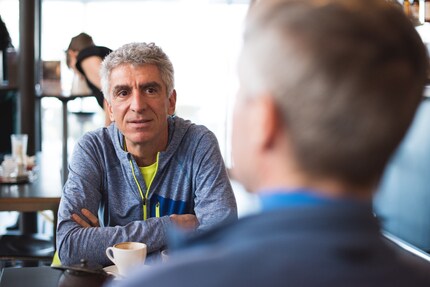
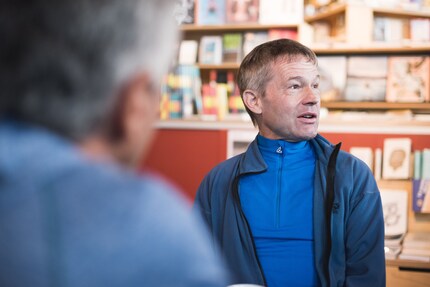
What made you want to run as a guide with visually impaired people?
Mike Bär, guide: The first time I saw tandem runners was at a marathon in the USA. There were four or five teams from China who were travelling as tandems. That totally fascinated me. Six months later, I took part in a marathon in the Atacama Desert at around 4,500 metres above sea level. I came across a video of a visually impaired runner from Ireland who had competed the year before. It was overwhelming to see that. I also found out later that her guide had broken down completely at the time and both of them had repeatedly fallen in the rough terrain. At some point, the Irish woman had had enough. She left her guide and simply asked another runner if he could lead her to the finish. Which he did. It was then clear to me that I wanted to do the same. What am I saying, I just had to do it. Back in Switzerland, I then found the Limmattal running club.
Mike has now been accompanying Hans-Peter Schmid on his runs for around three years. A friendship has developed between the two men during this time. I want to know from Mike what the specific job of a guide is. "Simply put, to run with a visually impaired person," he replies. For them, however, this would continue in the meantime. Mike also accompanies Hans-Peter to competitions.
How does a race day work?
It's important to prepare properly for the race: where do we run, what does the terrain look like, where do we pick up our race number, where do we get changed, where can we warm up? How do we get to the start and how do we get home after the race? Just all the organisational questions.
And in the race itself?
The most important thing is that your colleague doesn't fall down. That's the be-all and end-all. And then there are the "normal" problems of every runner. We wear orange waistcoats, which identify Hans-Peter as a runner with a visual impairment and me as a guide. Nevertheless, there are car drivers who don't stop at pedestrian crossings. There are cyclists, people with pushchairs, people with dogs - nobody gives way. There are also obstacles such as roots in the ground, kerbs, traffic dividers and so on. It's not always easy to get through without an accident. The worst thing would be if Hans-Peter were to fall, which thankfully hasn't been the case so far.
Where do you train?
We are often at Greifensee. A lap there is 17 kilometres long and it's pleasant on the good surface. We haven't been to the city for a long time. There are just too many people in summer. And when we do go into the city, we often run along the lake basin.
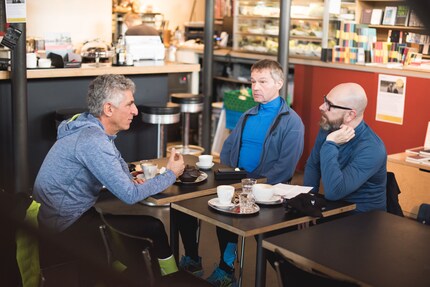
The two of them set a decent pace on their runs. Hans-Peter completes the half marathon in under 1:45:00. His best time over 42.195 kilometres is 3:54:00. With times like that, even guide Mike reaches his limits. After all, he doesn't "just" have to run with Hans-Peter, he has to guide him safely to the finish. The two of them smile when I want to know who has to look out for whom. The diplomatic answer is that it depends on the form of the day.
Where did you complete your training as a guide?At the Limmattal running club.
And what does it look like?
The training consists of a one-day basic course and two refresher courses. There is a theoretical and a practical part. Here you run with different glasses that simulate different eye conditions. For example, you only see light/dark or your field of vision is severely restricted. You have the feeling of looking through a tube. Or you can't see anything at all. After these three days of training, you run with a visually impaired person and a guide who coaches you. Then it's off you go.
What are the biggest difficulties?
There are many things that we underestimate. A kerb alone can be a major obstacle for a visually impaired person. Recognising these obstacles correctly and, above all, in good time is not easy. Let's stick with this example. I have to make sure that Hans-Peter always walks over a kerb at a 90-degree angle, otherwise he will buckle. So always run straight towards such an obstacle, never at an angle. You learn things like that in training. But you know what, Patrick? Here's a blindfold, I'll show you.
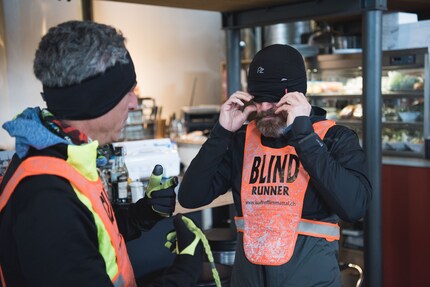
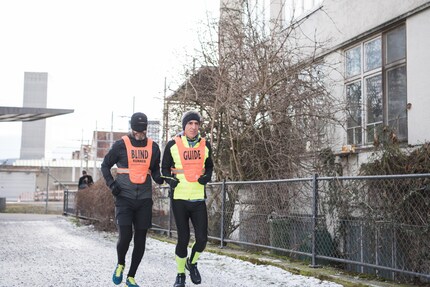
Okay, I put on the blindfold and put myself in Mike's care for a few minutes. We walk along the Limmat and are connected by a ribbon. We try to run with roughly the same stride length and as synchronised as possible. Mike tells me what's coming up next. "It's about to get slippery here, there's a cyclist coming towards us. There are dogs playing here, now we have to walk a few steps instead of running." Things like that.
On the way back, we walk along the road. "Now you're about to hear the tram. Now we slow down, people get off, now we have to stop for a moment. Now we keep walking." Then we're back at the sphères. And I'm one impressive experience richer. Wow. I feel a deep sense of gratitude that Mike has guided me safely through the world. I let go and he took over. For a brief moment, I have to hold back my emotions so that I don't just fall around his neck.
Speaking of which: what about trust? After all, Hans-Peter is putting his health in the hands of someone else. "It was a lot more stressful for Mike than for me at first," he says calmly. He's just used to it. During his studies, he competed in cross-country skiing with guides and had already skied with various guides before Mike. But of course, you put yourself at the mercy of another person. There was no way around it. But now he has a guide who can keep up with him. Finally, he says with a laugh.
«We're running the Boston Marathon on 15 April.»
On short tempo runs, however, Hans-Peter "cheats" with Sandra. The young woman is even faster than Mike. And on ultra-long runs, Hans-Peter can count on the services of a triathlete. So he has the right guide for every purpose.
So Hans-Peter has to take it easy, Mike?
Yes, on good days that can happen. If he trains well and is injury-free, he's faster than me. But we both have the ambition to complete a marathon or half marathon in a decent time. Neither of us wants to be on the road for five hours or so.
And Hans-Peter is so fast that he has qualified for this year's Boston Marathon. The anticipation of this highlight is written all over both runners' faces.
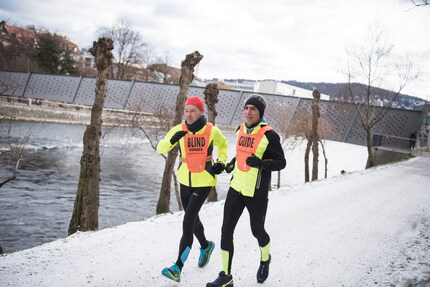
What Hans-Peter experienced in Boston, he has captured for you here:
Not going to miss any of my stories? Then follow my author profile here.
From radio journalist to product tester and storyteller, jogger to gravel bike novice and fitness enthusiast with barbells and dumbbells. I'm excited to see where the journey'll take me next.
Interesting facts about products, behind-the-scenes looks at manufacturers and deep-dives on interesting people.
Show all